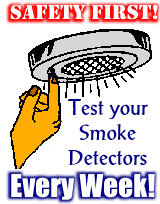
before fire has had time to spread. Fire, smoke and toxic gases move swiftly and silently
through a structure, reducing visibility and your ability to escape from the house safely.
Most fatal home fire occur at night, while people are asleep. Poisonous gases and smoke
from a fire in your home an numb the senses in a very short time. Every home needs a
device that can wake people up in time to escape. Of all the low-cost fire alarm devices that
are available a smoke alarm is the most effective.
Choosing a Smoke Alarm
There are several name brands available. Buy those that are Underwriters Laboratories
(UL) or Factory Mutual (FM) approved.
Smoke alarms are available for the hearing impaired and can be purchased through your
local fire equipment companies.
To get the protection you paid for, it's vital that you follow the manufacturer's
recommendations for installation, testing and maintenance.
How Many Smoke Alarms Do You Need?
Install at least one smoke alarm outside each sleeping area and one on each level of the
home. We strongly recommend that you install one alarm inside each bedroom.
Smoke alarms are not recommended for kitchens because of false alarms from cooking
vapors, or garages where automobile exhaust might cause false alarms, or for attics or other
unheated spaces where extremes of temperature or humidity might effect their operation. In
these areas you should install a heat detector.
Installation - Where and How?
If you are a renter, the property owner is responsible for installing and maintaining alarms.
To install most smoke alarms, all you need is a screwdriver and a drill.
Because smoke rises, each alarm should be mounted high on a wall or on the ceiling to
detect traces of smoke
Wall mounted alarms should be no less than 4" or nor more than 12" from the ceiling.
Ceiling mounted detectors should be at least 4" from a wall.
Smoke alarms should not be mounted near air vents.
Maintenance
It's extremely important to test and clean all detectors regularly.
It only takes a moment to test a smoke alarm. You need to test your alarm at least once a
month and most alarms are equipped with a test button or follow the manufacture's
instructions.
Dust or cobwebs can reduce an alarms sensitivity to smoke. Clean your smoke alarm at
least 3-4 times a year by using the brush end of your vacuum cleaner.
Replace the batteries at least once a year if the alarm is battery operated.
Smoke alarms need to be replaced every ten years.
Never paint a smoke alarm.
